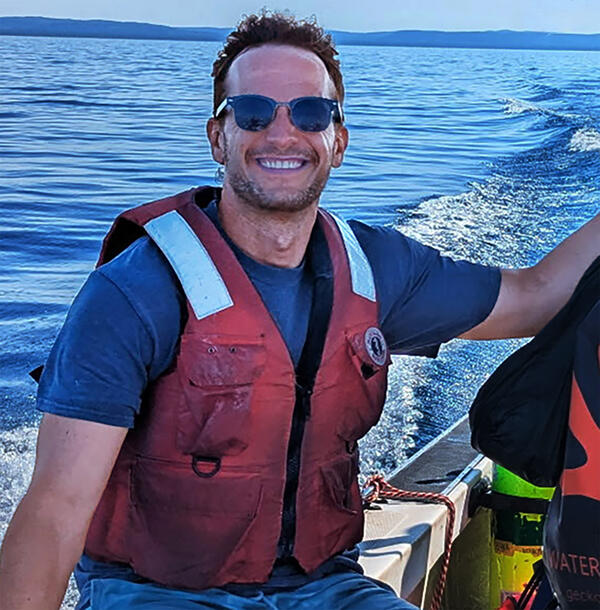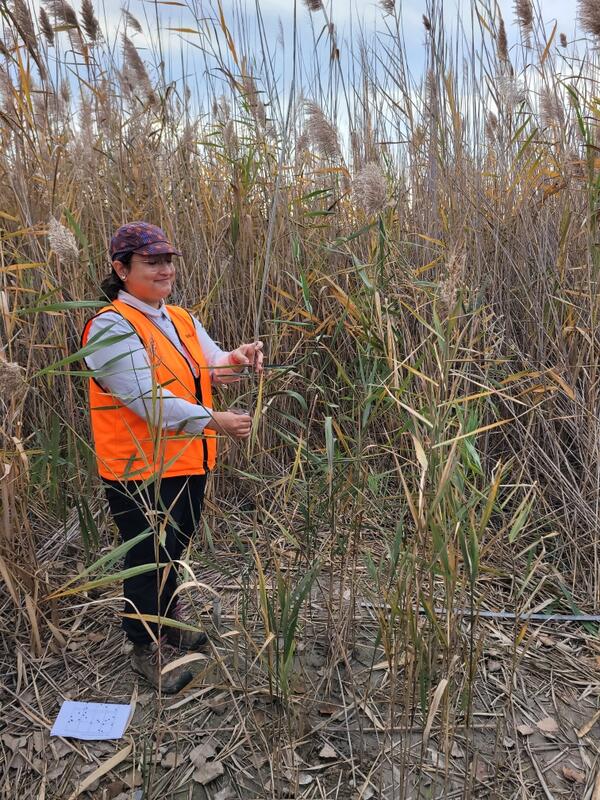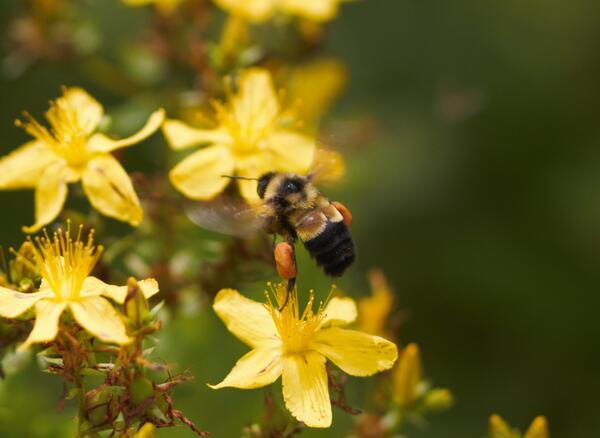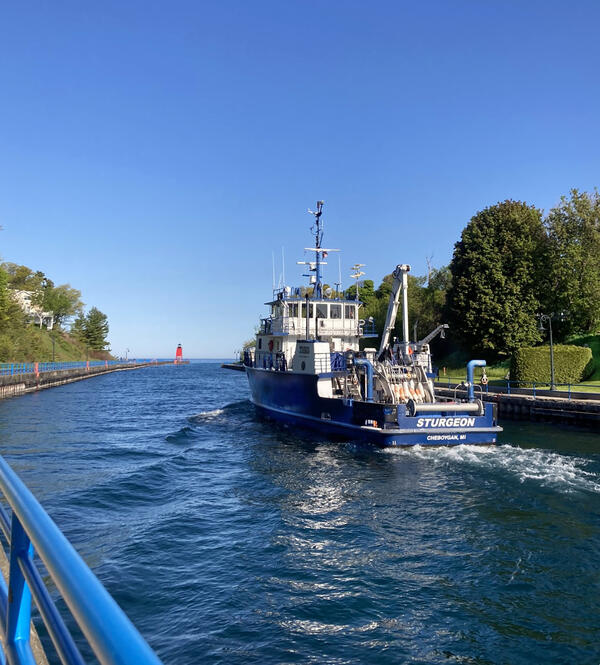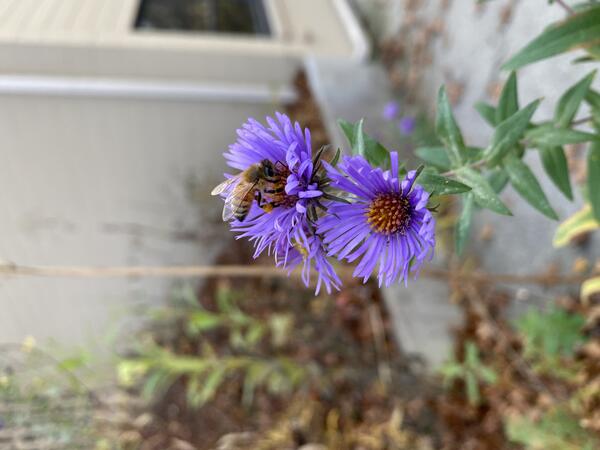Dr. Benjamin Kramer is shown on a small research vessel in July 2025 near Sleeping Bear Dunes in Leelanau County, MI collecting benthic mats on Good Harbor Reef as part of USGS's UMESC SWIM (Spawning Whitefish Invasive Mussels) project. Photo Credi: Megan Lewan, USGS
Images
Images captured by GLSC scientists while working in and around the Great Lakes.
Dr. Benjamin Kramer is shown on a small research vessel in July 2025 near Sleeping Bear Dunes in Leelanau County, MI collecting benthic mats on Good Harbor Reef as part of USGS's UMESC SWIM (Spawning Whitefish Invasive Mussels) project. Photo Credi: Megan Lewan, USGS
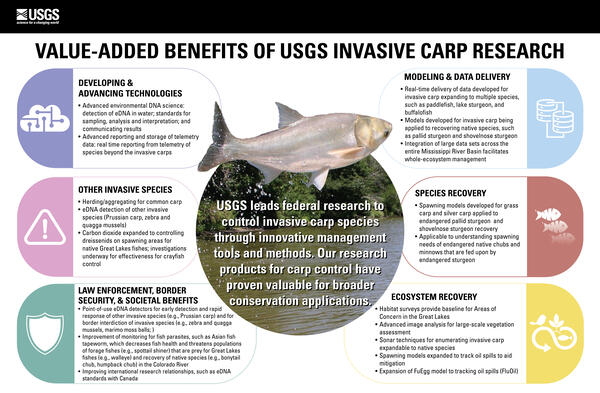
Value-added Benefits of USGS Invasive Carp Research
Value-added Benefits of USGS Invasive Carp ResearchThe USGS leads federal research to control invasive carp species through innovative management tools and methods. Our research products for carp control have proven valuable for broader conservation applications.
DEVELOPING & ADVANCING TECHNOLOGIES
Value-added Benefits of USGS Invasive Carp Research
Value-added Benefits of USGS Invasive Carp ResearchThe USGS leads federal research to control invasive carp species through innovative management tools and methods. Our research products for carp control have proven valuable for broader conservation applications.
DEVELOPING & ADVANCING TECHNOLOGIES
Olivia Mitchinson demonstrates alewife otolith removal to participants of angler workshop held at the State University of New York in Oswego. Otoliths are the structures that allow a fish to hear by picking up vibrations in the water. Photo credit: Jacob Bulich, USGS.
Olivia Mitchinson demonstrates alewife otolith removal to participants of angler workshop held at the State University of New York in Oswego. Otoliths are the structures that allow a fish to hear by picking up vibrations in the water. Photo credit: Jacob Bulich, USGS.
Three-dimensional reconstruction of a short section of lakebed imagery into a color point cloud (top) and orthomosaic (bottom), with a zoomed in view (right). These georeferenced data products are typical to many mobile platforms. Photo credit: Phil Wernette, USGS.
Three-dimensional reconstruction of a short section of lakebed imagery into a color point cloud (top) and orthomosaic (bottom), with a zoomed in view (right). These georeferenced data products are typical to many mobile platforms. Photo credit: Phil Wernette, USGS.
A USGS intern surveys non-native Phragmites australis at a research site in Milan, Michigan, following an experimental non-toxic bioherbicide treatment in 2024. Photo credit: USGS.
A USGS intern surveys non-native Phragmites australis at a research site in Milan, Michigan, following an experimental non-toxic bioherbicide treatment in 2024. Photo credit: USGS.
A researcher closing an incision after surgical implantation of an acoustic transmitter in a lake whitefish, October 2024. Photo credit: Brad Buechel, USGS.
A researcher closing an incision after surgical implantation of an acoustic transmitter in a lake whitefish, October 2024. Photo credit: Brad Buechel, USGS.
Gill net float at entrance to backwater habitat set to capture Grass Carp in the lower Huron River, OH. Photo credit: James Roberts, USGS.
Gill net float at entrance to backwater habitat set to capture Grass Carp in the lower Huron River, OH. Photo credit: James Roberts, USGS.
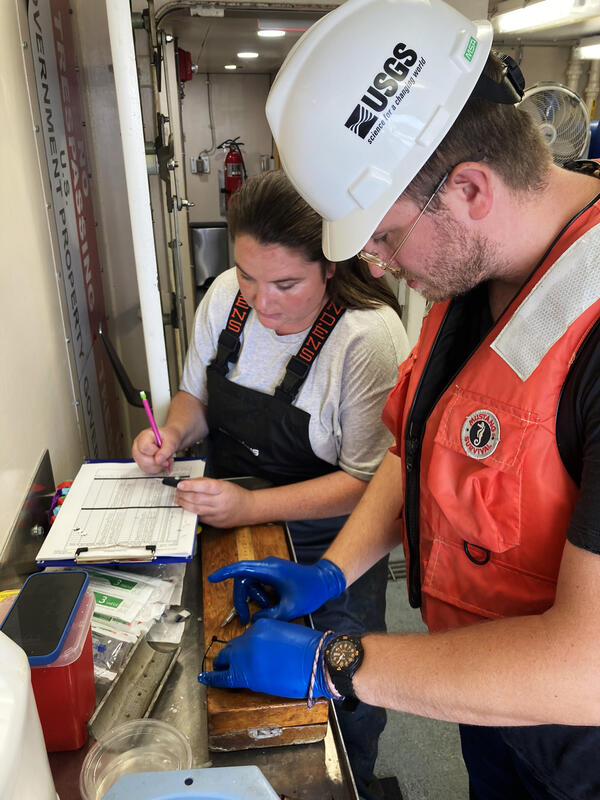
Fish Glucose Analysis Aboard the Research Vessel Arcticus
Fish Glucose Analysis Aboard the Research Vessel ArcticusUSGS researchers (GLSC; Cortland, New York; Ann Arbor, Michigan) collecting and recording fish glucose levels from specimens caught during a Lake Michigan bottom trawl survey aboard the R/V Arcticus. Data was used to test alternative processing methods to inform future Great Lakes Science Center International Animal Care and Use Committee (IACUC)
Fish Glucose Analysis Aboard the Research Vessel Arcticus
Fish Glucose Analysis Aboard the Research Vessel ArcticusUSGS researchers (GLSC; Cortland, New York; Ann Arbor, Michigan) collecting and recording fish glucose levels from specimens caught during a Lake Michigan bottom trawl survey aboard the R/V Arcticus. Data was used to test alternative processing methods to inform future Great Lakes Science Center International Animal Care and Use Committee (IACUC)
A rusty patched bumble bee-the only federally endangered bee in the lower 48 states-visits a St. John’s wort at the Ledgeview Nature Center in Calumet County, Wisconsin, July 2024. Photo credit: Bethany Dennis, USGS.
A rusty patched bumble bee-the only federally endangered bee in the lower 48 states-visits a St. John’s wort at the Ledgeview Nature Center in Calumet County, Wisconsin, July 2024. Photo credit: Bethany Dennis, USGS.
USGS divers gather samples on the Thunder Bay Reef complex in July 2024 to assess the abundance of mussels and lakebed algal growth two years before treatment. Photo credit: Madeleine Giordano, USGS.
USGS divers gather samples on the Thunder Bay Reef complex in July 2024 to assess the abundance of mussels and lakebed algal growth two years before treatment. Photo credit: Madeleine Giordano, USGS.
Crew of the USGS Great Lakes Science Center R/V Muskie (Huron, Ohio) testing bottom trawl equipment in Lake Erie off the coast of Cleveland, Ohio, in preparation for the upcoming field season. Photo credit: Kevin Keretz, USGS
Crew of the USGS Great Lakes Science Center R/V Muskie (Huron, Ohio) testing bottom trawl equipment in Lake Erie off the coast of Cleveland, Ohio, in preparation for the upcoming field season. Photo credit: Kevin Keretz, USGS
USGS Great Lakes Science Center R/V Sturgeon heading home to Cheboygan Vessel Base (Cheboygan, Michigan) after a spring gillnet survey in the Northern Refuge of Lake Michigan. This survey is completed annually and has been ongoing since 2001.
USGS Great Lakes Science Center R/V Sturgeon heading home to Cheboygan Vessel Base (Cheboygan, Michigan) after a spring gillnet survey in the Northern Refuge of Lake Michigan. This survey is completed annually and has been ongoing since 2001.

Teaching Early Life History and Fish Identification
Teaching Early Life History and Fish IdentificationGLSC’s Stacey Ireland and attendees reviewing a larval fish identification at the OMNRF Field Office in Wheatley, Ontario. Photo Credit: Robin DeBruyne, USGS.
Teaching Early Life History and Fish Identification
Teaching Early Life History and Fish IdentificationGLSC’s Stacey Ireland and attendees reviewing a larval fish identification at the OMNRF Field Office in Wheatley, Ontario. Photo Credit: Robin DeBruyne, USGS.
Sea lampreys in a tank at the Great Lakes Fishery Commission. Sea lampreys are a parasitic invasive species in the Great Lakes.
Sea lampreys in a tank at the Great Lakes Fishery Commission. Sea lampreys are a parasitic invasive species in the Great Lakes.
Photo of the first ever sea lamprey reared in the laboratory at the USGS Hammond Bay Biological Station (GLSC; Millersburg, MI) to undergo transformation (metamorphosis), which entails moving from the larval life stage to the parasitic life stage. Photo credit: Trisha Searcy, USGS.
Photo of the first ever sea lamprey reared in the laboratory at the USGS Hammond Bay Biological Station (GLSC; Millersburg, MI) to undergo transformation (metamorphosis), which entails moving from the larval life stage to the parasitic life stage. Photo credit: Trisha Searcy, USGS.
USGS researchers (GLSC; Cortland and Oswego, New York) fertilize cisco (Coregonus artedi) eggs from adults captured in Chaumont Bay, Lake Ontario that were transported to Little Sodus Bay, Lake Ontario and seeded on cleaned substrate within the bay. Photo credit: Marc Chalupnicki, USGS.
USGS researchers (GLSC; Cortland and Oswego, New York) fertilize cisco (Coregonus artedi) eggs from adults captured in Chaumont Bay, Lake Ontario that were transported to Little Sodus Bay, Lake Ontario and seeded on cleaned substrate within the bay. Photo credit: Marc Chalupnicki, USGS.
Toronto's skyline at sunset from Humber Bay in Lake Ontario. Photo credit: Alden Tilley, USGS.
Toronto's skyline at sunset from Humber Bay in Lake Ontario. Photo credit: Alden Tilley, USGS.
USGS marine maintenance repairer and ship operator (GLSC; Cheboygan, Michigan) ready the trawl doors at sunset as the R/V Sturgeon heads out for a night of work to search for ciscos (Coregonus artedi) on Lake Huron. Photo credit: Patty Dieter, USGS.
USGS marine maintenance repairer and ship operator (GLSC; Cheboygan, Michigan) ready the trawl doors at sunset as the R/V Sturgeon heads out for a night of work to search for ciscos (Coregonus artedi) on Lake Huron. Photo credit: Patty Dieter, USGS.
A honey bee (genus Apis) observed visiting an aster; a great observation for potential environmental DNA that can be recovered. Photo credit: Leslie Reyes, USGS Contractor.
A honey bee (genus Apis) observed visiting an aster; a great observation for potential environmental DNA that can be recovered. Photo credit: Leslie Reyes, USGS Contractor.
The GLSC’s R/V Sturgeon leaves Charlevoix, Michigan at the end of a lake trout spawner gillnet survey on Lake Michigan to head home to the Cheboygan Vessel Base (GLSC; Cheboygan, Michigan). Photo credit: Patty Dieter, USGS.
The GLSC’s R/V Sturgeon leaves Charlevoix, Michigan at the end of a lake trout spawner gillnet survey on Lake Michigan to head home to the Cheboygan Vessel Base (GLSC; Cheboygan, Michigan). Photo credit: Patty Dieter, USGS.
A USGS technician (GLSC; Ann Arbor, Michigan) throws the gillnet buoy flag overboard during a fall gillnet survey on Lake Michigan aboard the GLSC’s R/V Sturgeon. Photo credit: Patty Dieter, USGS.
A USGS technician (GLSC; Ann Arbor, Michigan) throws the gillnet buoy flag overboard during a fall gillnet survey on Lake Michigan aboard the GLSC’s R/V Sturgeon. Photo credit: Patty Dieter, USGS.


